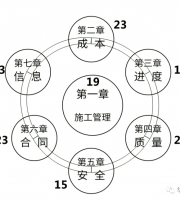According to the general state of construction production, the risk points are divided into three levels
. 
The project manager shall organize relevant personnel to confirm the risk points, formulate special schemes or measures, and submit them to the construction management department of the company for countersignature and filing
.
1、 The first level risk points include the following contents: 1
.
Deep foundation pit engineering
.
The excavation depth is more than 5m (including 5m), or the basement is more than three floors (including three floors), or the depth is not more than 5m (including 5m), but the geological conditions, surrounding environment and underground pipelines are extremely complex
.
2
.
Underground excavation works
.
Underground excavation and tunnel engineering with complex geology such as karst cave, underground river, gas, rock burst, mud gushing and fault
.
3
.
High formwork engineering
.
The formwork support system of horizontal concrete component with height over 8m, span over 18m, total construction load over 10kN / m2, or concentrated line load over 15kn / m
.
4
.
Work at height of 30m and above
.
5
.
Demolition blasting of urban houses and other large-scale earth rock blasting works( 2) The second level risk points include the following: 1
.
Foundation pit support and dewatering engineering
.
Foundation pit support engineering refers to the excavation depth of more than 5 m (including 5 m) foundation pit (groove) and the use of support structure construction engineering; Or the foundation pit is not more than 5m, but the geological conditions and surrounding environment are complex, and the groundwater level is above the bottom of the pit
.
2
.
Form work
.
All kinds of tool type formwork engineering, including slipform, climbing formwork, large formwork, etc; Horizontal concrete component formwork support system and special structure formwork engineering
.
3
.
Lifting works
.
4
.
Scaffolding works
.
Floor type steel pipe scaffold with height over 24m, attached lifting scaffold (including integral lifting and split lifting), cantilever scaffold, door type scaffold, hanging scaffold, hanging basket scaffold and unloading platform
.
5
.
Demolition and blasting works
.
The project is demolished manually, mechanically or by blasting
.
6
.
Other dangerous projects
.
For example: the installation and construction of building curtain wall, prestressed structure tension construction, tunnel engineering construction, bridge engineering construction (including bridge erection), special equipment construction, grid structure and cable membrane structure construction, slope construction above 6m; The use of new technology, new process and new materials may affect the quality and safety of the construction project, which has been approved by the administration and has no technical standards
.
7
.
External power protection engineering
.
Including: 10kV High voltage transformer protection, 10kV High voltage overhead line protection
.
8
.
Steel structure engineering( 3) The third level risk points include the following contents: 1
.
Foundation pit (trench) with excavation depth less than 5m (excluding 5m), and other earthwork with supporting structure construction
.
2
.
Floor type steel pipe scaffold with height less than 24m
.
3
.
Vertical transport machinery and equipment
.
Tower crane, truck (crawler) crane, external elevator, derrick, gantry, etc
.
4
.
Other mechanical equipment construction
.
Loader, excavator, concrete pump (car), pile driver, tipper, etc
.
5
.
Asbestos tile roof construction
.
6
.
Fire safety of building structure insulation engineering
.
7
.
Fire safety of cooling tower installation project
.
8
.
Fire safety of waterproof engineering
.
9
.
Fire safety and demolition of temporary buildings on construction site
.
10
.
Other projects that affect the safety of surrounding buildings (structures)
.
2、 Management measures of construction risk points 1
.
Special safety scheme must be formulated for grade I risk points, which shall be approved by the technical director of the company and demonstrated by experts
.
The expert group shall not be less than 5 persons, and shall submit a written demonstration and review report on the special safety construction scheme, which shall be used as an attachment to the special safety construction scheme, and fill in the “expert demonstration form for more dangerous projects” (table aq-c1-4 of “Regulations for management of safety data on construction site of construction projects”)
.
In the process of implementation, the construction should be organized in strict accordance with the special safety scheme, and the emergency rescue plan should be formulated
.
2
.
A special safety plan must be formulated for the secondary risk points, which shall be approved by the technical director at the next higher level, organized and implemented by the project engineer, and the emergency rescue plan shall be formulated
.
3
.
The third level risk points must formulate safety technical measures, which shall be approved by the project engineer, organized and implemented by the person in charge of relevant disciplines of the project, and the emergency rescue plan shall be formulated
.
4
.
Project engineering must establish risk point control management documents
.
The document shall include the following contents: 1) project overview
.
Including project location, building area, structural form and height, foundation depth, scaffold form, surrounding environment, etc
.
2) Risk point grade analysis
.
According to the general contract, the risk points in the whole construction process shall be classified according to this standard, and the person in charge of each risk point shall be specified
.
3) Risk point prevention and control measures
.
According to the risk point analysis, according to the relevant technical regulations and specifications, formulate special safety programs or measures, and organize experts to demonstrate
.
4) Make emergency plan
.
According to the guidelines for the compilation of emergency plans for work safety accidents of production and business operation units (AQ / t9002-2006), the emergency plans should include: emergency organizations and their responsibilities and authorities, list of relevant contact persons, available resources around, personnel training, emergency materials preparation and provision of material support, financial support, reporting procedures of various risk points, emergency management and emergency management Emergency pre control measures, emergency rescue command position and rescue team action route, evacuation route and important location identification, etc
.
5) Fill in the summary sheet of more dangerous projects (aq-c1-5) and the summary sheet of risk point control (see the annex)
.
5
.
Before the construction of risk points, special safety technical disclosure shall be carried out, and the receiver must sign on the disclosure one by one
.
Construction at risk points is strictly prohibited without safety disclosure
.
6
.
During the construction of the first and second risk points, the safety officer shall supervise the whole process; During the construction of three-level risk points, the safety officer should implement key monitoring
.
Disclaimer: this website
.



